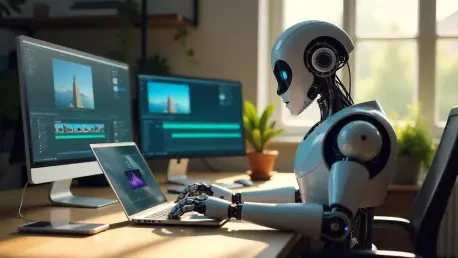As advancements in artificial intelligence (AI) reshape various industries, video production is experiencing a profound transformation driven by the power of AI. This evolution marks a significant departure from traditional methods, ushering in innovations that redefine content creation, editing, and distribution. Picture this: Hollywood blockbusters alongside social media content, each enriched and streamlined by AI’s capabilities. As democratization takes root in video production, even small enterprises and individuals harness AI tools to produce professional-grade content without requiring expensive equipment or technical expertise. Yet, AI’s influence stretches beyond accessibility, presenting myriad possibilities that promise monumental changes. AI-powered editing suites can now transform footage remarkably quickly, and virtual actors are adept in diverse languages. These unfolding advancements are set to dominate video production, each trend breathing new life into how stories are crafted, presented, and perceived.
1. AI-Generated Content: From Text to Video
AI is making remarkable strides in creating video content from simple text inputs, offering dynamic multimedia experiences that encompass voiceovers, graphics, and animations. This breakthrough is particularly advantageous in sectors where rapid video production is critical, such as e-learning, marketing, and news coverage. It revolutionizes how content is conceptualized and delivered by enabling text-to-video conversion, which simplifies the generation of interactive media. Moreover, AI produces contextual B-roll footage, enhancing narrative clarity and visual engagement. This technological leap affords creators the opportunity for automated storyboard development, transforming written narratives into vivid visual sequences. The expanding prowess of AI-generated content is cementing its role in swiftly producing high-quality videos tailored to specific needs. As this phenomenon progresses, video production becomes increasingly efficient, enriching storytelling techniques while broadening creative horizons.
AI-driven content creation also heralds an era of personalization, adapting subject matter to diverse audience preferences seamlessly. Beyond generating basic narratives, AI systems can modify content based on specific viewer data, creating a tailored experience that resonates more profoundly. This manifests in personalized marketing campaigns with heightened engagement rates thanks to intelligently curated visual stories. The application of AI extends to e-commerce, where product demonstrations can be vividly customized to align with individual consumer preferences, promoting standout user experiences. In educational contexts, adaptive learning videos leverage AI to match the pace and comprehension level of students, offering tailored instruction that fosters deeper understanding. These unprecedented capabilities not only cater to consumer preferences but also enhance communication, simplifying how messages are crafted and shared across various domains.
2. Integration of AR and VR Technologies
Augmented and virtual reality (AR and VR) technologies are merging with AI, creating captivating video experiences that transform viewer engagement. This integration fosters immersive storytelling by weaving AI-generated virtual environments into narratives, offering vivid immersion that bridges the gap between viewers and content. Through real-time object recognition and overlay, AR videos provide a dynamic interface with immediate information access, enriching the visual experience considerably. This sophisticated interaction transforms video into a communicative tool that immerses users in fictive yet lifelike worlds. In consumer-focused sectors like fashion and cosmetics, virtual try-ons powered by AI have revolutionized user experiences, providing previews of products in rich, adaptable virtual settings. This profound advancement redefines how stories are told and how products are anticipated and understood.
Furthermore, the blending of AI with AR and VR invites creators and audiences to navigate uncharted territory in content storytelling. This synergy enables novel, engaging formats, nudging video production into new realms where traditional methods find themselves rapidly outdated. The creation of AI-driven virtual environments fosters multisensory engagement, allowing viewers to experience narratives beyond the visual dimension. Innovations in these domains also fuel enhanced interactivity, reshaping how stories unfold and how viewers immerse themselves in storytelling. Whether involving direct user interaction or dynamic scenery modification, AI’s contributions to AR and VR reshape creative possibilities in video production. These advances underscore the critical role AI plays in making video content more engaging, immersive, and multi-dimensional.
3. AI-Enhanced Mobile Videography
AI continues to redefine mobile videography, empowering everyday devices with capabilities once reserved for professionally engineered setups. Smartphones, which have become ubiquitous video production tools, now benefit from AI enhancement in stabilization, audio fidelity, and editing sophistication. Advanced image stabilization driven by AI ensures handheld footage remains smooth and uniform, mitigating jarring movements traditionally associated with mobile capture. Simultaneously, AI-powered noise reduction and audio enhancement improve auditory experiences, affording clarity unrivaled in mobile videography history. These developments signify a transformative leap, enabling content creators to increase production quality using mere handheld devices. With scene optimization tailored to ambient lighting conditions, AI does away with the need for meticulous manual adjustment. Users can now produce high-quality video content with impressive ease, as AI handles complex refinement processes without fuss.
Moreover, AI-powered mobile videography extends creative possibilities by offering complex editing features directly on portable devices. Techniques that once required extensive post-production processing are now accessible at creators’ fingertips through AI’s sophisticated algorithms. The technology automates meticulous tasks, from frame composition to color correction, widening access to impactful content creation methodologies. Integration and optimization of video components become streamlined and accessible, allowing creators to focus on engaging storytelling rather than technical challenges. As mobile devices adopt AI-driven enhancements, the video production sphere witnesses substantial democratization, making high-quality videography accessible to wider audiences globally. This evolution provides a diverse, rich canvas for creative expressions, reimagining how content is curated, customized, and distributed.
4. AI Voice Generators
AI voice technology has reached remarkable maturity, redefining narrative delivery in video production and offering advanced capabilities for lifelike voiceovers. These AI voice generators excel in producing multilingual narrations with astonishing authenticity, allowing vivid content accessibility across cultural boundaries. A significant advantage lies in the increased personalization made possible through AI voice generation. Tailoring voice characteristics to specific narrative tones or branded identities enhances user engagement, crafting more genuine audience experiences. The technology also introduces real-time voice synthesis, particularly beneficial in live and virtual reality performances, where immersive interaction is essential. Such advancements promise to elevate viewer experiences in ways previously unattainable, manifesting in countless creative possibilities across diverse interactive platforms.
AI voice generators continue to break new ground with features like voice modulation, essential for more natural-sounding narrations that mimic human cadences and nuances closely. This brings credibility to audio content, bridging the gap between digital and human expressions, crucial for empathic storytelling. Interactive audio experiences, driven by AI’s intelligent algorithms, further enhance user engagement by incorporating adaptable, responsive audio elements within videos. Character-specific voice generation, particularly in animated content, provides creators the latitude to authentically express diverse personalities within narratives. These capabilities invite novel methods for producing impactful audio-visual compositions, broadening how stories resonate with audiences globally. As this technology evolves, AI voice generation plays a critical role in shaping meaningful and immersive video storytelling experiences.
Conclusion
As artificial intelligence (AI) advances, it’s transforming video production in remarkable ways, signaling a significant shift from traditional methods. This evolution introduces groundbreaking innovations that redefine how content is created, edited, and shared. Imagine Hollywood blockbusters paired with social media content, all heightened and refined by AI’s potential. With video production becoming more accessible, small businesses and individuals now use AI tools to produce quality content without needing costly equipment or deep technical know-how. AI’s impact goes further than just accessibility, offering numerous possibilities that could revolutionize the industry. AI-driven editing software can swiftly enhance footage, and virtual actors now perform seamlessly in various languages. These developments are set to lead video production, redefining how stories are crafted, delivered, and understood. Each trend breathes new life into storytelling, positioning AI as a crucial player in the evolution of video content.









